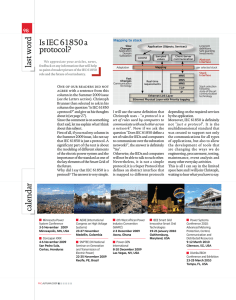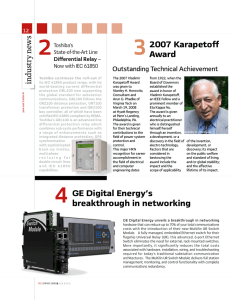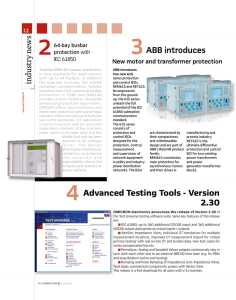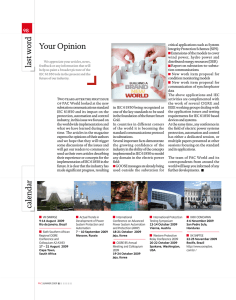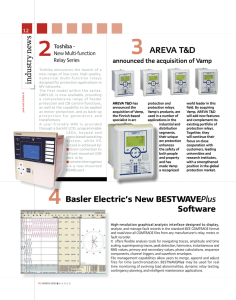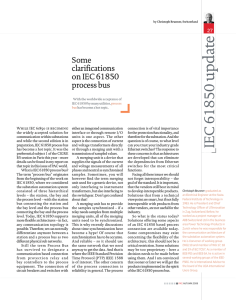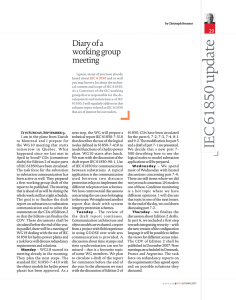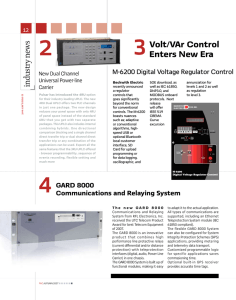Document 11002501
advertisement
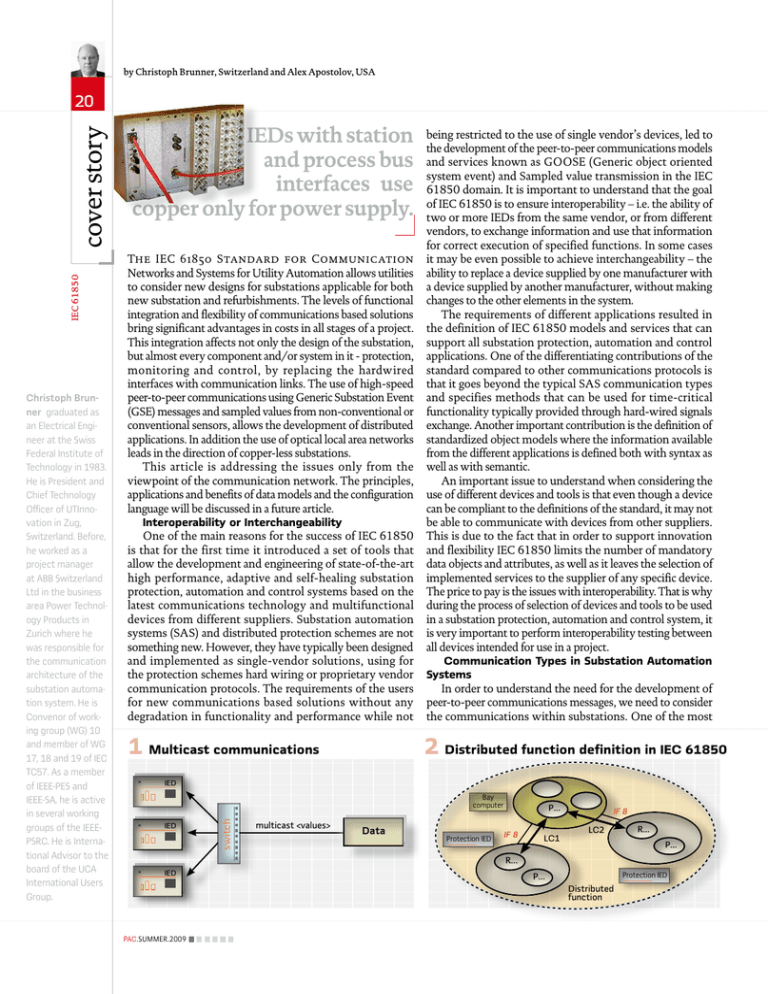
by Christoph Brunner, Switzerland and Alex Apostolov, USA Christoph Brunner graduated as an Electrical Engineer at the Swiss Federal Institute of Technology in 1983. He is President and Chief Technology Officer of UTInnovation in Zug, Switzerland. Before, he worked as a project manager at ABB Switzerland Ltd in the business area Power Technology Products in Zurich where he was responsible for the communication architecture of the substation automation system. He is Convenor of working group (WG) 10 and member of WG 17, 18 and 19 of IEC TC57. As a member of IEEE-PES and IEEE-SA, he is active in several working groups of the IEEEPSRC. He is International Advisor to the board of the UCA International Users Group. IEDs with station and process bus interfaces use copper only for power supply. The IEC 61850 Standard for Communication Networks and Systems for Utility Automation allows utilities to consider new designs for substations applicable for both new substation and refurbishments. The levels of functional integration and flexibility of communications based solutions bring significant advantages in costs in all stages of a project. This integration affects not only the design of the substation, but almost every component and/or system in it - protection, monitoring and control, by replacing the hardwired interfaces with communication links. The use of high-speed peer-to-peer communications using Generic Substation Event (GSE) messages and sampled values from non-conventional or conventional sensors, allows the development of distributed applications. In addition the use of optical local area networks leads in the direction of copper-less substations. This article is addressing the issues only from the viewpoint of the communication network. The principles, applications and benefits of data models and the configuration language will be discussed in a future article. Interoperability or Interchangeability One of the main reasons for the success of IEC 61850 is that for the first time it introduced a set of tools that allow the development and engineering of state-of-the-art high performance, adaptive and self-healing substation protection, automation and control systems based on the latest communications technology and multifunctional devices from different suppliers. Substation automation systems (SAS) and distributed protection schemes are not something new. However, they have typically been designed and implemented as single-vendor solutions, using for the protection schemes hard wiring or proprietary vendor communication protocols. The requirements of the users for new communications based solutions without any degradation in functionality and performance while not being restricted to the use of single vendor’s devices, led to the development of the peer-to-peer communications models and services known as GOOSE (Generic object oriented system event) and Sampled value transmission in the IEC 61850 domain. It is important to understand that the goal of IEC 61850 is to ensure interoperability – i.e. the ability of two or more IEDs from the same vendor, or from different vendors, to exchange information and use that information for correct execution of specified functions. In some cases it may be even possible to achieve interchangeability – the ability to replace a device supplied by one manufacturer with a device supplied by another manufacturer, without making changes to the other elements in the system. The requirements of different applications resulted in the definition of IEC 61850 models and services that can support all substation protection, automation and control applications. One of the differentiating contributions of the standard compared to other communications protocols is that it goes beyond the typical SAS communication types and specifies methods that can be used for time-critical functionality typically provided through hard-wired signals exchange. Another important contribution is the definition of standardized object models where the information available from the different applications is defined both with syntax as well as with semantic. An important issue to understand when considering the use of different devices and tools is that even though a device can be compliant to the definitions of the standard, it may not be able to communicate with devices from other suppliers. This is due to the fact that in order to support innovation and flexibility IEC 61850 limits the number of mandatory data objects and attributes, as well as it leaves the selection of implemented services to the supplier of any specific device. The price to pay is the issues with interoperability. That is why during the process of selection of devices and tools to be used in a substation protection, automation and control system, it is very important to perform interoperability testing between all devices intended for use in a project. Communication Types in Substation Automation Systems In order to understand the need for the development of peer-to-peer communications messages, we need to consider the communications within substations. One of the most 1 Multicast communications 2 Distributed function definition in IEC 61850 IED Bay computer IED switch IEC 61850 cover story 20 multicast <values> Data Protection IED P... IF 8 LC1 IF 8 LC2 R... P... R... IED Protection IED P... Distributed function PAC.SUMMER.2009 21 commonly used is Client – Server. The client in this domain can be defined as a device or function that sends a message to a server device or function, requesting from the server to perform a specific task (service). The client application usually manages the user-interface portion of the application, validates data entered by the user or sends requests to the servers. The client-based process is the front- end of the application that the user sees and interacts with in the substation automation system. A server device or function fulfills the client request by performing the requested task. Most IEDs in the substation operate as servers while interfacing with substation level devices or applications. A typical Client/Server operation is a complete transaction consisting of a request followed by information delivery of the requested information. It is important to note that one server can respond to the requests of multiple clients and vice versa. Usually, operational data except commands, flows primarily from the server to the clients. The Client/Server communications can also be described as connection-oriented, which means that the devices at the end points establish an end-to-end connection before any data is sent. Connection-oriented communications are considered a more reliable network service, because they guarantee that data will arrive in the proper sequence. The Transmission Control Protocol (TCP) is a connection-oriented protocol. The problem with Client/Server communications is that due to their principles they can not meet the requirements for performance, especially for protection applications. This resulted in the idea for development of different types of communications based on a Connectionless method. In this case data is sent from one device to another without prior arrangement. Connectionless protocols are usually described as stateless, because the end points have no protocol-defined 3 Logical interfaces in Substation Automation Systems (SAS) Remote control (NCC) Technical services 7 10 FCT. A FCT. B 9 STATION LEVEL 1.6 3 Remote protection Transfer time t = ta + tb + tc 3 Contr. 2 Prot. 4.5 Process Interface 4.5 Censors ta Contr. 2 BAY/UNIT LEVEL Alex Apostolov received MSEE, MSAM and Ph.D. degrees from the Technical University in Sofia, Bulgaria. He has more than 30 years experience in protection, automation and communications. He is presently Principal Engineer at OMICRON electronics in Los Angeles, CA. He is IEEE Fellow and Member of the Power Systems Relaying Committee and Substations C0 Subcommittee. He serves on many IEEE PES working groups and is Chairman of Working Group C9. He is Member of CIGRE and is Convener of CIGRE WG B5.27. He is US representative in IEC TC 57 WG 10, 17, 18. He holds three patents and has authored and presented more than 300 technical papers. 4 Transfer time definition 1.6 8 Prot. way to remember where they are in a "conversation" of message exchanges. Since an IED transmits data to another device without first ensuring that the recipient is available and ready to receive the data, there is no guarantee that the data will be received. The device sending a message simply sends it addressed to the intended recipient. Because of that IEC 61850 has introduced specific mechanisms to ensure the delivery of the data to the recipients. The connectionless communication methods used in IEC 61850 are also referred to as peer-to-peer or publisher / subscriber communication. Peer-to-peer or publisher / subscriber is the characteristic communications type for the IEC 61850 based systems. It is one of the distinguishing features of the standard that makes it attractive to protection and control specialists. It describes the ability of arbitrary pairs of IEDs connected to the substation network to manage the exchange of information as necessary with all devices having equal rights, in contrast to the master/slave communication. Unlike the client / server communication, the publisher / subscriber communication does not need to establish and maintain an association for the information exchange (Figure 1). Publisher / Subsrciber communications in IEC 61850 based systems use multicast for data delivery. It is a method that allows the sending IED to deliver the information simultaneously to a group of destination IEDs using the most efficient strategy - to send the messages over the network only once. By comparison with multicast, conventional point-to-single-point delivery is called unicast. Publisher / Subscriber communications are used to perform protection, control, monitoring and recording functions. Any function can be divided into sub-functions and functional elements. The functional elements are the smallest parts of a function that can exchange data. These functional elements in IEC 61850 are called Logical Nodes. When a function is executed based on the exchange of communications messages between two or more devices, it is called “distributed function”. The exchange of data is not only between functional elements, but also between different levels of the substation functional hierarchy. It should be kept in mind that functions at different levels of the functional hierarchy can be located in the same physical device, and at the same time different physical devices can be exchanging data at the same functional level. Figure 2 shows Logical Connections (LC) - tb GOOSE tc transfer time Remote protection Actuators fi Communication processor Communication processor fk is the time between PROCESS LEVEL fuctions in two HV Equipment Physical device PD[n] Physical device PD[m] devices PAC.SUMMER.2009 IEC 61850 cover story 22 The IEC 61850 GOOSE and sampled values messages belong to the performance class with highest transmission requirements - less than 1/4 of a cycle between functions. the communication links between functional elements - in this case logical nodes of the P and R groups. IEC 61850 also defines interfaces that may use dedicated or shared physical connections - the communication links between physical devices. The allocation of functions between different physical devices defines the requirements for the physical interfaces, and in some cases may be implemented into more than one physical LANs. The functions in the substation can be distributed between IEDs on the same, or on different levels of the substation functional hierarchy. IEC 61850 defines three such levels: Station Bay/Unit Process These levels and the logical interfaces are shown by the logical interpretation of Figure 3. IEC 61850 publisher / subscriber communication focuses on a subset of the interfaces shown in Figure 3 with Interface 8 (shown in red) being used for high-speed peer-to-peer communications between IEDs and interface 4 – for transmission of sampled values between the sensors and the IEDs. In order to implement high-speed protection and control functions over the substation local area network, we need to make sure that the system will meet some specific performance requirements. Different distributed functions impose different performance requirements that have to be considered in the design process of substation protection, control, monitoring and recording systems. There are two independent groups of performance classes: For control and protection For metering or power quality applications Since the performance classes are defined according to the required functionality, they are independent from the size of the substation. The requirements for control and protection are higher, because of the effect of the fault clearing time on the stability of the system or on sensitive loads. IEC 61850 defines three Performance Classes for such applications: P1 - applies typically to the distribution level of the substation or in cases where lower performance requirements can be accepted. P2 - applies typically to the transmission level or if not otherwise specified by the user. P3 - applies typically to transmission level applications with high requirements, such as bus protection. IEC 61850 transfer time definition is based on Figure 4: The overall performance requirements also depend on the message type. Type 1 is defined in the standard as Fast Messages. Since Trip (Type 1A) is the most important fast message in the substation, it has more demanding requirements compared to all other fast messages. The same performance may be requested for interlocking, intertrips and logic discrimination between protection functions. For message type 1A, the following requirements are defined: For Performance Class P1, the total transmission time shall be in the order of half a cycle. Therefore, 10 ms is defined. For Performance Class P2/3, the total transmission time shall be below the order of a quarter of a cycle. Therefore, 3 ms is defined for the high-speed peer-to-peer communications. PAC.SUMMER.2009 Virtual IED The IEC 61850 model includes data objects and services. The communications of data between different multifunctional IEDs working together in distributed functions are achieved over the substation LAN. In order to understand the specific features included in the IEC 61850 design of high-speed peer-to-peer communications, we need to understand the type of Ethernet frames being used. IEC 61850 GSE Model High-speed publisher / subscriber communications in IEC 61850 based protection and control systems use a specific method designed to meet a variety of requirements. It is very important to understand, that the concept of the Generic Substation Event (GSE) model is not based on commands, but on the sending indication by a function that a specific substation event has occurred. It is designed to support reliable high-speed communications between different devices or applications and allows the replacement of hard-wired signals between devices with communication messages exchange, while improving the functionality of the protection, automation and control system. The model 5 Publisher/subscriber mechanism Subscriber Physical Device ASCI Server Data Data Application Physical Device Physical Device ASCI Server ASCI Server Data GSE message Data Data Data Application Application Publisher Subscriber 23 One of the main goals of IEC 61850 is to ensure interoperability between devices from different manufacturers. Devices from different manufacturers are mapped to a common data model - virtual IED includes several features that can be used to with logical improve the reliability and availability of the system. At the same time the proper use of devices and these features in vendors’ implementation will allow a reduction in maintenance and logical nodes. increase in the flexibility of the system. To understand the reasons for these benefits, we need to look into some of the details of the Generic Substation Event model. The GSE method can be considered as a mechanism for reporting by a logical device. The achievement of speed performance, availability and reliability depends on the implementation in any specific device. The generic substation event model is used to exchange the values of a collection of Data Attributes defined as a Data Set. The GSE information exchange is based on a publisher/ subscriber mechanism (Figure 5). The publisher writes the values in a transmission buffer at the sending side and multicasts them over the substation local area network to the different subscribers. The data in the published GOOSE messages is a collection of values of data attributes defined as members of a data set. The receiver reads the values from a local buffer at the receiving side. A GSE control class in the publisher is used to control the process. If the value of at least one of the DataAttributes has changed, the transmission buffer of the Publisher is updated with the local service “publish” and the values are transmitted with a GOOSE message. Specific communication services in the subscribers update the content of their reception buffers and new values received are indicated to the related applications. Since the GOOSE messages replace hard-wired signals used for protection and control applications, IEC 61850 introduces mechanisms that ensure the delivery of the required information (Fig ure 6). Once a new value of a date attributed has resulted in the multicasting of a new GOOSE message, the repetition mechanism ensures that the message is sent with a changing time interval between the repeated messages until a new change event occurs. As shown in Figure 6, at the beginning after a change the interval is very short – a few milliseconds, which later increases until it reaches a value of a few seconds. This method achieves several important tasks: Ensures that a loss of a single message is not going to affect the functionality of the system Allows any new device to inform all subscribing devices about its state Allows any new device to learn the state of all publishing devices it subscribes to Allows any device requiring information from a publisher to supervise that the publisher is still alive, even if no change event occurs The GOOSE messages contain information that allows the receiving devices to know not only that a status has changed, but also the time of the last status change. This allows a receiving device to set local timers relating to a given event. As already mentioned, the content of the GOOSE message allows the receiving devices to perform processing of the data in order to execute required actions. Some of the attributes in the GOOSE message related to these functions are the time stamp representing the time at which the current state number changed for the first time, sequence number – the value of a counter that increments each time a GOOSE message with the same values has been sent and the Test - a parameter that indicates that the GOOSE message is used for test purposes. IEC 61850 Process Bus IEC 61850 based connection to switchgear and sensors is typically called process bus. While much of this communication can be based on the communication services mapped in IEC 61850-8-1, the connection of instrument transformers with a digital interface requires the transmission of an analogue waveform as a stream of sampled values. For that purpose, the service "transmission of sampled values" has been introduced. The mapping of that service is not defined in IEC 61850-8-1, but in IEC 61850-9-2. The use of a digital interface to conventional or non conventional instrument transformers result in further improvements and can help eliminate some of the issues related to the conflicting requirements of protection and metering IEDs. The interface of the instrument transformers (both conventional and non-conventional) with different types of substation protection, control, monitoring and recording equipment is through a device called a Merging Unit. This is defined in IEC 61850-9-1 as: “Merging unit: interface unit PAC.SUMMER.2009 High-speed peer-to-peer communications in IEC 61850 are based on a publisher/ subscriber mechanism. IEC 61850 cover story 24 Some of the built-in features in GOOSE can be used to improve the security of substation PAC systems. that accepts multiple analogue CT/VT and binary inputs, and produces multiple time synchronized serial unidirectional multi-drop digital point to point outputs to provide data communication via the logical interface 4. It is important to be able to interface with both conventional and non-conventional sensors in order to allow the implementation of the system in existing or new substations. The Merging unit (as can be seen from Figure 7) is comparable to the analog input module of a conventional protection or other multifunctional IED. The difference is that in this case the substation LAN performs as the digital data bus between the input module and the protection or functions in the device. They are located in different devices, just representing the typical IEC 61850 distributed functionality (Figure 7). There are several important differences between the data sampling in a microprocessor based relay and the process bus as defined in IEC 61850: While in the relays the sampling is controlled by the IED and may use frequency tracking, in IEC 61850 all interface or merging units are time synchronized with accuracy better than 1 microsecond and use a fixed number of samples per cycle at the nominal frequency The sampled values in the IED are exchanged directly between the A/D converter and the processor, while in IEC 61850 they are transmitted using typically multicast from the merging unit (publisher) to all IEDs (subscribers) that need these sampled values Interoperability between merging units and IEDs is ensured through the standard. A certain level of interchangeability is ensured through documents providing implementation guidelines. Two modes of sending sampled values between a merging unit and a device that uses the data are defined. For protection applications the merging units send 80 samples/ cycle in 80 messages/cycle, i.e each Ethernet frame has the MAC Client Data contain a single set of V and I samples. For waveform recording applications, such a sampling rate may not be sufficient. That is why 256 samples/cycle can be sent in groups of 8 sets of samples per Ethernet frame sent 32 times/cycle . The sampled analogue values model applies to the exchange of values of a DATA-SET. The data of the data set are of the common data class SAV (sampled analogue value as defined in part IEC 61850-7-3). A buffer structure is defined for the transmission of sampled values from the instrument transformer logical nodes TCTR and TVTR (Figure 8). The information exchange for sampled values is based on a publisher/subscriber mechanism. The publisher writes the values in a local buffer at the sending side (see Figure 5), while the subscriber reads the values from a local buffer at the receiving side. A time stamp is added to the values, so that the subscriber can check the timeliness of the values and use them to align the samples for processing. The communication system shall be responsible to update the local buffers of the subscribers. A sampled value control (SVC) in the publisher is used to control the communication procedure. The currents and voltages from TCTR and TVTR accordingly are delivered as sampled values over the substation LAN. In this case the network becomes the data bus that provides the interface between the instrument transformer logical nodes and the different logical nodes that are used to model the functional elements of the IED. Depending on the requirements, the user can design it with different communications architectures as described in the next section of the article. 7 Merging unit block diagram 8 Bus differential based on sampled analog values 6 GOOSE repetition mechanism max. Repetition Interval fast Repetitions max. Repetition Interval Time new Event: Data Change Merging units can be considered as shared analog input modules. TCTR Merging Unit Amplifiers, Filters Analog circuit Group Delay D1 Calibrator Time Synchronization 1 pps PAC.SUMMER.2009 Analog to Digital Converter Digital Signal Processing Group Delay D2 IEC 61859 9-2 SAV TVTR Data Set and SAV Formatting Merging Unit Bus Differential PDIF SAV 61859-9-2 25 IEC 61850 Substation Architectures IEC 61850 is being implemented gradually by starting with adaptation of existing IEDs to support the new communications standard over the station bus and at the same time introducing some first process bus based solutions. Full advantage of all the features available in the new communications standard can be taken if both the station and process bus are used. IEC 61850 communications based distributed applications involve several different devices connected to a substation local area network as shown in the simplified block diagram in Figure 9. Merging Units (MU) process the sensor inputs while binary input/output units can be used to monitor the status of the breaker and trip or close it when necessary based on the GOOSE messages it receives from the different IEDs. The merging unit and the input/output unit can be combined in a single device – a process interface unit (PIU) as shown in Figure 9. All multifunctional IEDs then receive sampled values messages and binary status messages, process the data (including re-sampling in most of the cases), make a decision and operate by sending a GSE message to the IOU to trip the breaker or perform any other required action. Figure 10 is an illustration of how the substation design changes when the full implementation of IEC 61850 takes place. All copper cables used for analog and binary signals exchange between devices are replaced by communication messages over fiber. If the DC circuits between the substation battery and the IEDs or breakers are put aside, “copper-less” substation is a fact. The next possible step when using station and process bus is the optimization of the switchgear. In order for the protection, control and monitoring functions in a substation to operate correctly several instrument transformers are placed throughout the high voltage installation. However with the capability to send voltage and current measurements as sampled values over a local area network it is possible to eliminate some of these instrument transformers. One example is the voltage measurements needed by distance protections. Traditionally voltage transformers are installed in each outgoing feeder. However if voltage transformers are installed on the busbar, the voltage measurements can be transmitted over the local area network to each function requiring these measurements. IEC 61850 Process Bus Benefits Process bus based applications offer some important advantages over conventional hard wired analog circuits. The first very important one is the significant reduction in the cost of the system due to the fact that multiple copper cables are replaced with a small number of fiber optic cables. Using a process bus also results in the practical elimination of CT saturation because of the elimination of the current leads resistance.The impedance of the merging unit current inputs is very small, thus resulting in a significant reduction in the possibility for CT saturation and all associated with it protection issues. Process bus based solutions also improve the safety of the substation by eliminating one of the main 9 Station and process bus functional architecture Substation HMI Gateway to SCADA Ethernet Network - Station Bus IED IED IED IED IED Ethernet Network - Process Bus PIU PIU PIU PIU PIU safety related problems - an open current circuit condition. Since the only current circuit is between the secondary of a current transformer and the input of the merging unit located right next to it, the probability for an open current circuit condition is very small. It becomes non-existent if optical current sensors are used. Last, but not least, the process bus improves the flexibility of the protection, monitoring and control systems. Since current circuits can not be easily switched due to open circuit concerns, the application of bus differential protection, as well as some backup protection schemes becomes more complicated. The above is not an issue with process bus, because any changes will only require modifications in the subscription of the protection IEDs receiving the sampled analog values over IEC 61850 9-2. 10 Substation design with process and station bus The use of IEC 61850 station and process bus practically IU IU IU eliminates copper cables from the Ethernet Switch substation. Multifunctional Device PAC.SUMMER.2009

